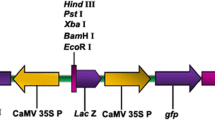Abstract
A sonication-assisted, Agrobacterium-mediated, co-cultivation technique was used in an attempt to increase the transformation efficiency of flax. Hypocotyls and cotyledons excised from about 10-day-old flax seedlings grown in vitro were placed into a 10 mM MgSO4 solution, and inoculated with an A. tumefaciens vector bearing the mgfp5-ER gene driven by the CaMV 35S promoter. The explants were subjected to pulses of ultrasound delivered by a sonicator apparatus (35 kHz) for 0–150 s and co-cultivated for 2 h at 27°C. The dried hypocotyls and cotyledons were grown on a selective MS medium to promote shoot regeneration. An electron microscopic study showed that the sonication treatment resulted in thousands of microwounds on and below the surface of the explants. A stereo microscope Leica MZ 12 equipped with a GFP adaptor was used to assess the infection and transformation of plant tissues in real time. After only 48 h and for at least 30 days after bacteria elimination, signs of transgene expression could be seen as a bright fluorescence. Our results show that treatment with ultrasound facilitates an enhanced uptake of plasmid DNA into the cells of flax hypocotyls and cotyledons and that its efficiency depends on the duration of the treatment and the frequency used. SAAT could be a promising tool for enhancing transformation efficiency in flax.






Similar content being viewed by others
Abbreviations
- BAP:
-
6-Benzylaminopurine
- CaMV 35S:
-
Cauliflower mosaic virus promoter
- GFP:
-
Green fluorescent protein
- GUS:
-
β-Glucuronidase
- Kn:
-
Kanamycin
- SEM:
-
Scanning electron microscopy
- NAA:
-
Naphthalene acetic acid
- gfp :
-
Green fluorescent protein gene
- mgfp5-ER :
-
Modified gene for Green fluorescent protein
- nptII :
-
Neomycin Phosphotransferase II gene
- nos (promoter):
-
Nopaline Synthase promoter
References
Ananthakrishnan G, Xia X, Amutha S, Singer S, Muruganantham M, Yablonsky S, Fischer E, Gaba V (2007) Ultrasonic treatment stimulates multiple shoot regeneration and explant enlargement in recalcitrant squash cotyledon explants in vitro. Plant Cell Rep 26:267–276. doi:10.1007/s00299-006-0235-1
Dong JZ, McHughen A (1993) An improved procedure for production of transgenic flax plants using Agrobacterium tumefaciens. Plant Sci 88:61–71. doi:10.1016/0168-9452(93)90110-L
Flores Solís JI, Mlejnek P, Studená K, Procházka S (2007) Application of sonication-assisted Agrobacterium-mediated transformation in Chenopodium rubrum L. Plant Soil Environ 49:255–260
Fullner KJ, Cano LJ, Nester EW (1996) Pilus assembly by Agrobacterium T-DNA transfer genes. Science 273:1107–1109. doi:10.1126/science.273.5278.1107
Holford P, Hernandez N, Newbury HJ (1992) Factors influencing the efficiency of T-DNA transfer during co-cultivation of Antirrhinum majus with Agrobacterium tumefaciens. Plant Cell Rep 11:196–199
Horsch RB, Fry JE, Hoffman NL, Einchholtz D, Rogers SG, Fraley RT (1985) A simple and general method for transferring genes into plants. Science 227:1229–1231
Hraška M, Heřmanová V, Rakouský S, Čurn V (2008) Sample topography and position within plant body influence the detection of the intensity of green fluorescent protein (GFP) fluorescence in the leaves of transgenic tobacco plants. Plant Cell Rep (in press). doi:10.1007/s00299-007-0431-7
Jordan MC, McHughen A (1988) Glyphosate tolerant flax plants from Agrobacterium mediated gene transfer. Plant Cell Rep 7:281–284
Joersbo M, Brunstedt J (1990) Direct gene transfer to plant protoplasts by mild sonication. Plant Cell Rep 9:207–210. doi:10.1007/BF00232181
Joersbo M, Brunstedt J (1992) Sonication: a new method for gene transfer to plants. Physiol Plant 85:230–234. doi:10.1034/j.1399-3054.1992.850215.x
Ling HQ, Binding H (1997) Transformation in protoplast cultures of Linum usitatissimum and L. suffruticosum mediated with PEG and with Agrobacterium tumefaciens. J Plant Physiol 151:479–488
Millam S, Obert B, Preťová A (2005) Plant cell and biotechnology studies in Linum usitatissimum – a review. Plant Cell Tissue Organ Cult 82:93–103. doi:10.1007/s11240-004-6961-6
Mlynárová L, Bauer M, Nap JP, Preťová A (1994) High efficiency Agrobacterium-mediated gene transfer to flax. Plant Cell Rep. 13:282–285. doi:10.1007/BF00233320
Rakouský S, Tejklová E, Wiesner I, Wiesnerová D, Kocábek T, Ondřej M (1999) Hygromycin B − an alternative in flax transformant selection. Biol Plant 42:361−369. doi:10.1023/A:1002457000944
Tejklová E (1992) Long-term in vitro shoot-tip culture and plant regeneration in flax. Rost. Výroba (Praha) 28:1009–1022 (In Czech)
Trick HN, Finer JJ (1997) SAAT: sonicated-assisted Agrobacterium-mediated transformation. Transgenic Res 6:329–336. doi:10.1023/A:1018470930944
Trick HN, Finer JJ (2000) Use of Agrobacterium expressing green fluorescent protein to evaluate colonization of sonication-assisted Agrobacterium-mediated transformation-treated soybean cotyledons. Lett Appl Microbiol 30:406–410
Wijayanto T, McHughen A (1999) Genetic transformation of Linum by particle bombardment. InVitro Cell Dev-Pl 35:456–465
Wróbel M, Zebrowski J, Szopa J (2004) Polyhydroxybutyrate synthesis in transgenic flax. J Biotechnol 107:41–54. doi:10.1016/j.jbiotec.2003.10.005
Zaragozá C, Muñoz-Bertomeu J, Arrillaga I (2004) Regeneration of herbicide-tolerant black locust transgenic plants by SAAT. Plant Cell Rep 22:832–838. doi:10.1007/s00299-004-0766-2
Zhan XC, Jones DA, Kerr A (1988) Regeneration of flax plants transformed by Agrobacterium rhizogenes. Plant Mol Biol 11:551–559. doi:10.1007/BF00017455
Zhang LJ, Cheng LM, Xu N, Zhao NM, Li CG, Jing Y, Jia SR (1991) Efficient transformation of tobacco by ultrasonication. Biotechnology 9:996–997
Acknowledgements
The authors are grateful for the financial support received from Ministry of Education, Youth and Sport of the Czech Republic (grants 1M06030, 1PO5ME800). Linguistic revision was kindly performed by John McAvoy.
Author information
Authors and Affiliations
Corresponding author
Rights and permissions
About this article
Cite this article
Beranová, M., Rakouský, S., Vávrová, Z. et al. Sonication assisted Agrobacterium-mediated transformation enhances the transformation efficiency in flax (Linum usitatissimum L.). Plant Cell Tiss Organ Cult 94, 253–259 (2008). https://doi.org/10.1007/s11240-007-9335-z
Received:
Accepted:
Published:
Issue Date:
DOI: https://doi.org/10.1007/s11240-007-9335-z




